Olympus XZ-1 Review
Olympus XZ-1
Aimed at both beginners and enthusiasts, this Olympus compact has an f/1.8 lens.
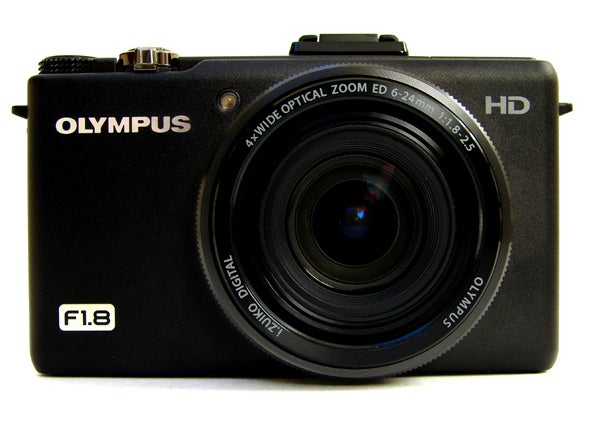
Verdict
Pros
- f/1.8 lens
- Good build quality
- Great image quality
Cons
- No automatic lens cover
- Bulky
Key Specifications
- Review Price: £399.00
- f/1.8 lens
- 4x optical zoom
- iAuto mode
With the release of what is arguably its first ‘high performance’ pocket compact in the 10-megapixel, 4x optical zoom XZ-1, Olympus is trying to target – and moreover enthuse – two distinct groups of photographer. First, there’s the beginner wanting to take better pictures than their current auto-everything model will allow. Second, we have the photography enthusiast looking for a smaller back up to complement their existing digital SLR. That’s without, presumably, wanting to alternatively invest in Olympus’ existing Digital Pen series of interchangeable lens compacts – another way to achieve close to DSLR quality without actually buying a DSLR.
While its manufacturer may be aiming to set a new benchmark for what’s achievable with the humble compact, in truth there’s already plenty of stiff competition for the XZ-1 to take on. There’s the equally portable Canon PowerShot S95 and G12, Nikon’s Coolpix P7000 and newer Coolpix P300, Panasonic’s Lumix DMC-LX5 and Samsung’s EX1. And these are soon to be joined by the Fujifilm FinePix X100, which on paper trumps the lot by incorporating a larger APS-C size sensor, as found in a number of DSLRs. Though we’ve yet to test the P300 and X100, we have to say that the rest are pretty damn fine alternatives for those after the best quality possible from a camera with a fixed lens – the Panasonic LX5 being our current favourite.
First impressions of the XZ-1 suggest that it is indeed a class act that deserves to stand shoulder to shoulder with existing high-performing rivals. As if you hadn’t already guessed, a current retail price a penny shy of £400 earmarks the Olympus XZ-1 from the outset as a premium compact. So, too, does the bright f/1.8 to f/2.5 Zuiko Digital-branded zoom lens bolted onto the front (matching the f/1.8 also offered by the Nikon P300 and Samsung EX1), twinned with a larger than average 1/1.63in, 11.3-megapixel CCD sensor.
The upshot should be usable, noise and blur-free results in natural light without having to reach for the extra illumination provided by the camera’s pop-up flash – which is neatly sunk within the top plate when not in use – as well as enabling a narrow depth of field to be captured. Incidentally, there’s a dedicated button for activating the flash located at the top left hand corner of the back plate. Slide this to the right and the flash pops up instantly with a satisfying and solid-sounding ‘clunk’. Wireless flash control is available from the XZ-1 should it be required.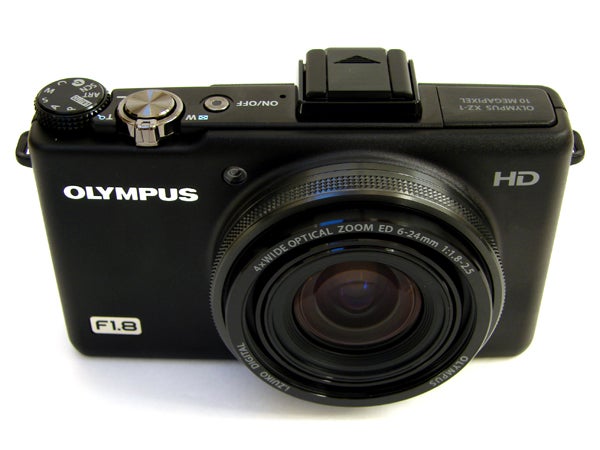
We had the compact XZ-1 in for testing alongside the new Olympus E-PL2 and, as expected, there are similarities between these closely priced and featured rivals. Both offer Raw and JPEG capture (recording to SD, SDHC or SDXC cards), an ISO range extending in steps up to ISO6400, dedicated one-touch record button that captures 1,280 x 720 video at 30fps. That’s in addition to an HDMI output, a top-mounted shooting mode dial and an infuriatingly fiddly scroll wheel at the back. Where you can swap the lens on the front of the E-PL2, you’re ‘stuck’ with the one on the XZ-1, as you are with all of the competitors we mentioned previously.
It’s lucky therefore, that said lens is an excellent example. The Olympus XZ-1’s (so-called) dual image stabilised (sensor shift plus ISO boost doesn’t really count) 4x optical zoom boasts a focal range equivalent to a wide 28mm to 112mm in 35mm film terms, so it’s useful for landscapes and group portraits and again comparable with its aforementioned rivals in that respect. Macro close ups at as near as 1cm from a given subject are possible too. This should make the XZ-1 a capable all-in-one option, so photographers buying one with that in mind won’t miss the fact that the lens cannot be changed.
Further adding to the impression that this is a serious proposition is the Olympus XZ-1’s rugged-feeling build, which suggests a compacted DSLR or, more closely still, a smaller and slimmer Digital Pen; a feeling augmented by the XZ-1’s 275g weight and proportions of 110.6mm x 64.8mm x 42.3mm. From the front it’s traditionally square-like and boxy and, in its black incarnation, even a bit plain looking (a natty white lacquered version is alternatively available). But as this is not your average point-and-shoot that requires stylish curves to sell it, we actually like its no-nonsense appearance. That said, although the XZ-1 is more portable than a Micro Four-Thirds model, it’s still one for transporting in the pocket of a jacket rather than jeans.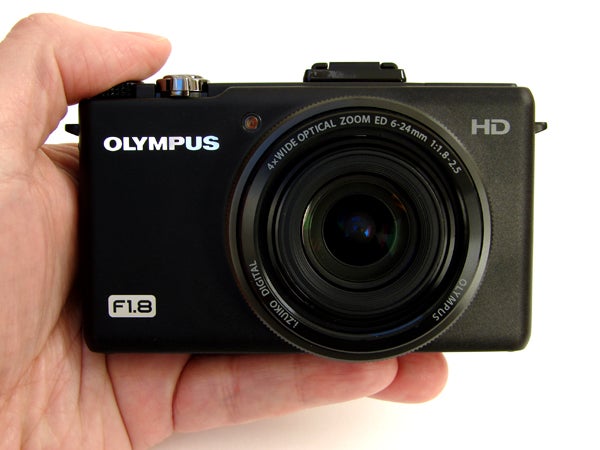
As an additional stand-out feature, the XZ-1 ‘borrows’ the time-saving idea of a lens ring, for making function adjustments on the quick, from rival Canon’s PowerShot S95. Thus, the likes of ISO speed can be scrolled through and swapped with a quick twist – the relevant settings adequately displayed within a narrow box at the bottom of the screen – rather than needing to drill down into the main menus. And again like the Canon, there’s the ability to adjust aspect ratios, from 4:3 to 3:2, 16.9 or even 6:6.
Not everything here is immediately obvious, however. A case in point is that a Canon-like toolbar, displayed at the side of the screen and featuring key shooting settings for swift and easy access, is called up with a press of the ‘OK’ button at the centre of its backplate control pad/scroll wheel. Though this proves a time saver, there’s no obviously marked ‘function’ button to guide you to it in the first place. In other words: the XZ-1 subjects you to an initial period of familiarisation.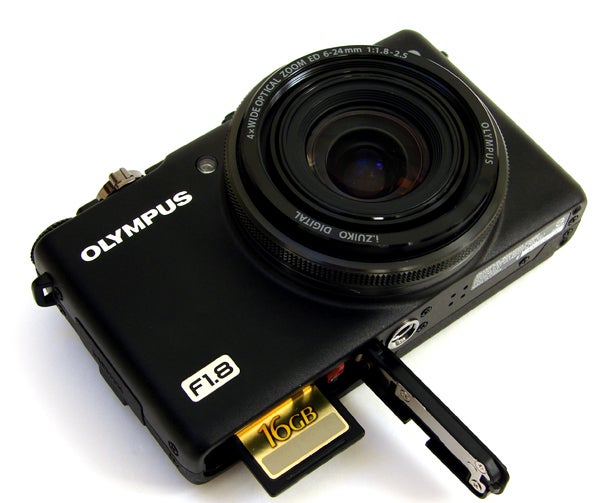
Like its slightly easier to fathom Samsung EX1 opponent, the XZ-1 breaks from tradition by offering a bright and clear OLED (as opposed to LCD) rear screen, here 3in in size and with a high 610k dot resolution. This can’t be tilted or swivelled though, which may be asking for too much perhaps, but would further extend the XZ-1’s creative possibilities.
Extending the basics of what’s on offer is instead left up to an accessory port tucked just behind the vacant hot shoe on the top plate. This is basically the same feature that we’ve seen on Olympus Digital Pen cameras since the E-P2. This allows for not just the attachment of an external flash, but also an electronic viewfinder (EVF) or external stereo microphone. Both the hot shoe and accessory port are protected from dust and grime by a sliding plastic cover, when not in use.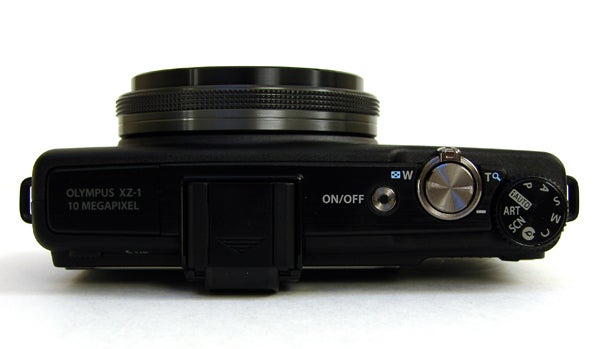
Also carried over from previous Olympus Pen compacts and E-series DSLRs, and worth flagging-up, is a handful of Art Filter digital effects. Here they are six in number and comprise Pop Art, Soft Focus, Grainy Film, Pin Hole, Diorama and Dramatic Tone. The Diorama feature is the increasingly ubiquitous ‘miniature effect’ mode by another name, aping the effect of a tilt-and-shift lens by narrowing the portion of the image in sharp focus.
The contrast and colour boosting Dramatic Tone mirrors the results achievable from compacts that offer high dynamic range modes, such as the HDR Art function on the recently reviewed Casio Exilim EX-ZR10. However the results from the Olympus are in a different league, and although one might argue inessential, certainly aren’t a gimmick either, as we’ll explain shortly.
The smattering of manual controls on the XZ-1, including the quartet of program, aperture priority, shutter priority and full manual, are joined on the same shooting mode dial by a user-attributable custom mode, dedicated low-light mode, reliable scene and subject-recognising iAuto for point and shoot simplicity, plus the aforementioned Art and subsequent ‘Scene’ modes. There are 18 of the latter, biased towards portraiture and landscapes in the main and including a simple to use but slow to process panorama mode.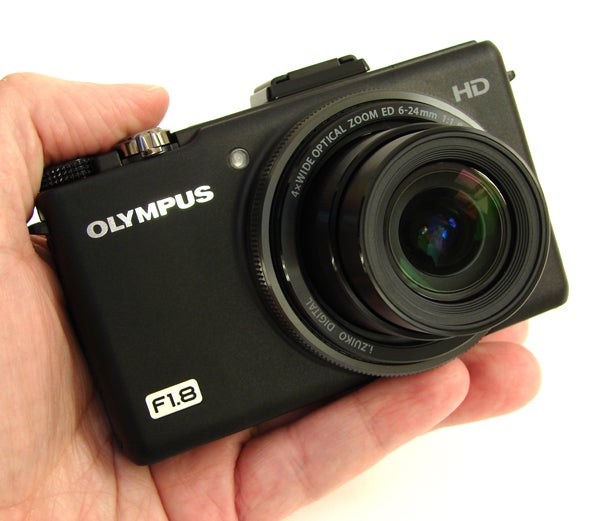
Slightly more unusually we also get a multi-exposure mode, and two underwater shooting settings. Incidentally we felt that the shooting dial itself was a little looser than it might have been – as we accidentally jogged settings fetching the camera in and out of a jacket pocket. The probability of this happening feels somewhat amplified by its positioning at the top right-hand edge of the camera’s top plate.
The overall impression given by the XZ-1’s control set is that, much like the Pen range, those photographers who want to get hands-on can, while those who would rather leave the tricky choices up to the camera are equally sated thanks to iAuto (intelligent Auto) mode. Turn the camera’s dial to iAuto and there’s a Live Guide feature, showing the effects of any setting changes in real time on screen, so that the user knows if they like the look before applying them.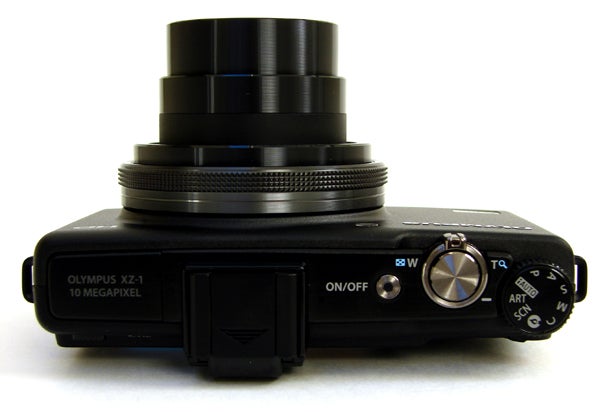
At the bottom of the tool bar are options to, for example, adjust colour saturation or blur the background; we also get an instructional ‘Shooting Tips’ section. Predictably, given the XZ-1’s intention to appeal to the broadest possible audience, this kicks off with recommendations on how to photograph children and pets.
The Olympus XZ-1 is quick to respond once turned on. A press of the small on/off button nestling next to the shutter release button, itself encircled by the zoom lever, and the lens shoots forward from its storage position to maximum wide angle setting. There’s no automatic sliding lens cover protecting the glass, just a plastic slip-on lens cap. The rear OLED screen blinks into life a mere moment later, the entire process from dormant to having a finger hovering over the shutter release button taking just under two seconds. It’s comparable to the kind of response you’d expect from a starter DSLR.
A half press of said shutter release and the Olympus borrows a trick from its DSLRs in being lightning quick to determine focus and exposure thanks to its contrast detection AF system; the appearance of the AF point, signified by the usual box highlighted in green (or red if you’re too close and focus can’t be determined), and beep of affirmation being nigh instantaneous. As expected, we also get AF tracking here, useful for subjects moving about the frame.
In single shot mode a full resolution JPEG takes around three seconds to write, which is about adequate. More positively, shooting and writing the alternative of an unprocessed Raw file takes a mere blink of an eye longer, as does shooting a Large, Fine JPEG and Raw file together. Incidentally, JPEGs at each of the four levels of compression offered, from a file of 3,648 x 2,736 pixels down to 640 x 480 pixels can be shot in tandem with a Raw file, as well as individually.
The OLED screen itself is commendably clear, the image relayed with its brighter-than-life colours noticeably digital in that respect in comparison with a plain old LCD. However, and having said that, what you see on the screen and what you get once shots are downloaded to your desktop are very similar, so we have no complaints as far as fidelity goes. Even exposures and good colours, veering toward the warm, are the order of the day.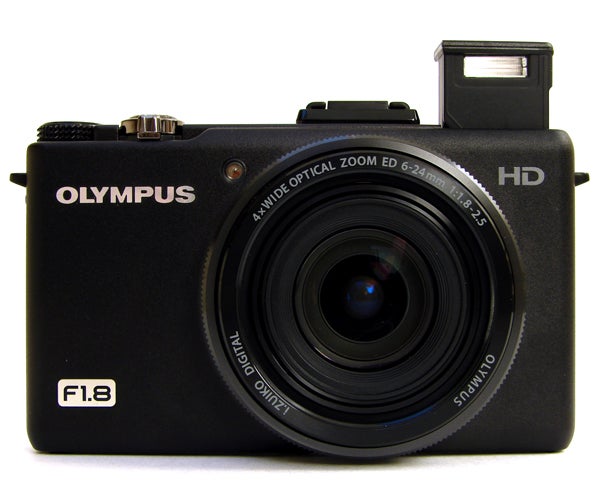
For us, while it doesn’t quite trump the ease of use offered by the Panasonic Lumix DMC-LX5, the results straight out of the Olympus are slightly more natural looking – if keeping the camera on Program or Intelligent Auto settings that is. Despite a sensor housing ‘just’ 10 megapixels, we were also very impressed by the amount of detail packed into the images, which, thanks also to the lens provided, is noticeably an improvement over your typical 14 megapixel ‘style cam’.
For those who want to add a bit of extra punch to images on a dull day, we found the Art Filters offered some pleasing results. These can transform the drab into the visually dynamic without any specialist Photoshop skills needed. What’s more, there’s the ability to select them when shooting video clips as well as mere stills, which again elevates this model by a creative notch for those looking for an all-round tool. And yes, the optical zoom can be utilised when shooting video.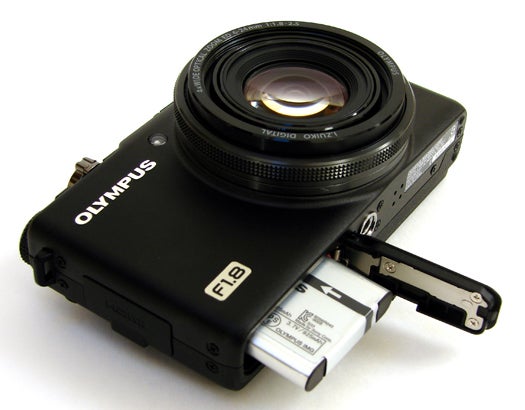
In terms of low light performance we’d be happy shooting up to and including ISO1600. The compromise of increased noise and softened detail if venturing any higher just isn’t worth it in our opinion. But then again, it could be argued that thanks to that brighter than average lens you won’t actually find yourself needing to reach for the higher ISOs anyway.
Admittedly, though there is much about the XZ-1 to admire and more to discover than its outwardly minimal appearance suggests, one alternatively could buy a starter digital SLR for the £400 being asked. Or stretch a little further and go for the E-PL2 Digital Pen. The beginner/keen amateur target markets for both Olympus cameras overlap to a degree. 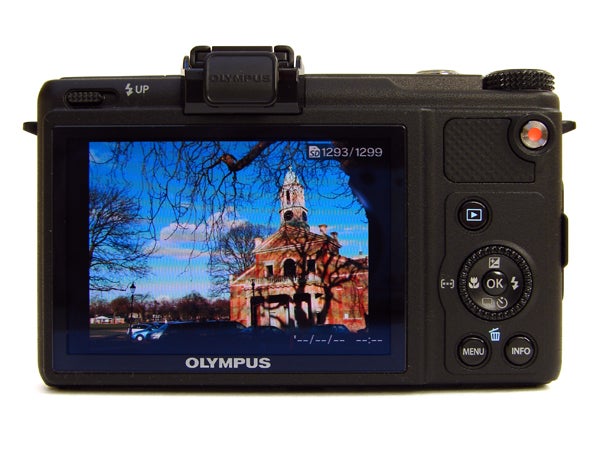
So, as with the rest of its closely matched opponents, you’ve got to want the added portability and convenience of this feature-packed, solidly built, all-in-one pocket compact, over the ability to extend your creative horizons over time with interchangeable lenses. In that respect then the XZ-1 probably works best as a sophisticated toy to complement the existing DSLR user, who isn’t already wedded to the Canon or Nikon brand and therefore isn’t more likely to go for the continuity in feel the likes of the S95 or P300 can offer.
Verdict
The XZ-1 feels like a good, solid move for its maker, and in helping the brand stay competitive and moreover relevant, it deserves to do well. Olympus has come lately to the high performance compact party, so it’s just as well that its arrival is with a product that should be awarded a degree of fanfare.
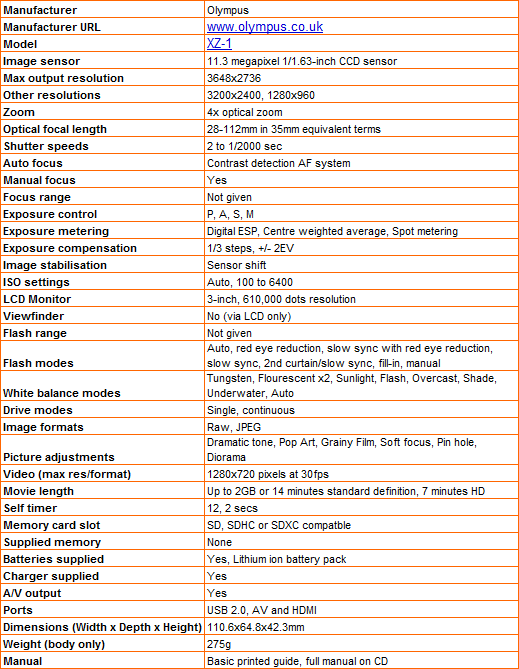
”’The following were all shot as highest quality JPEGs under available natural light, with automatic white balance deployed. Rather than show you every one of the 20 manually selectable incremental settings (if we include Auto ISO) that the XZ-1 provides, we’ve picked selected highlights to illustrate the camera’s overall performance.”’
—-

—-
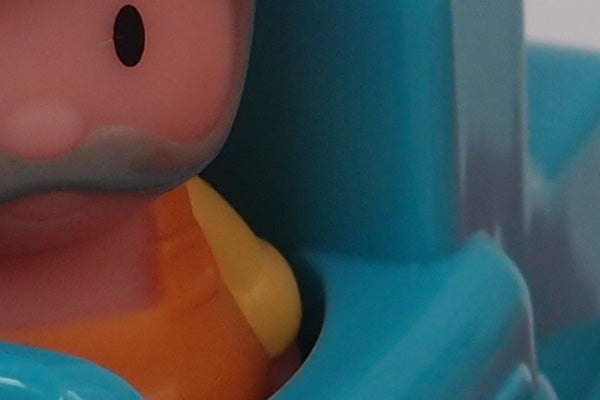
With ISO set to Auto, the camera has chosen ISO100 as being most fitting for the task, meaning there’s no chance of any image noise ruining proceedings.
—-
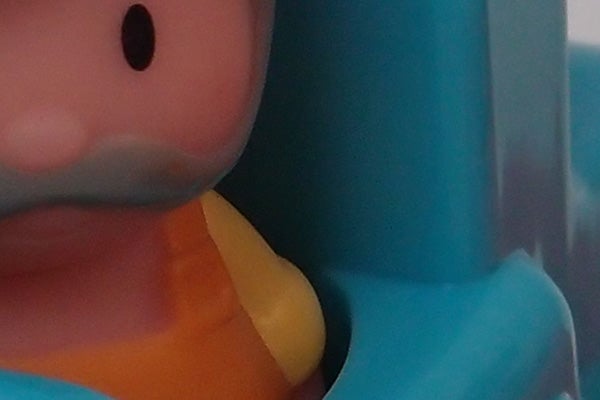
Same set up shot at ISO200 and similarly no image noise to report.
—-
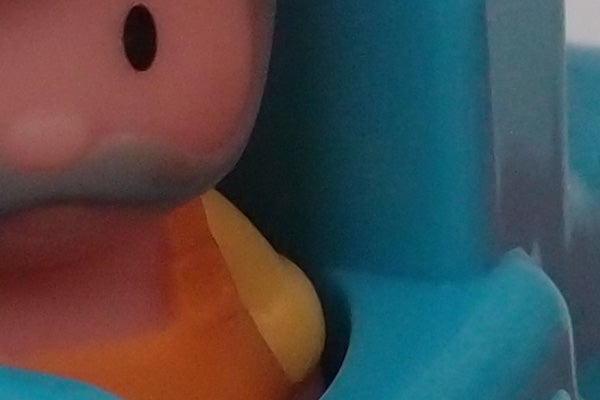
We’re at ISO400, the setting at which we’re most likely to see the first suggestion of grain and, true to form, some particularly subtle image noise is creeping in, revealing itself in shadow areas.
—-
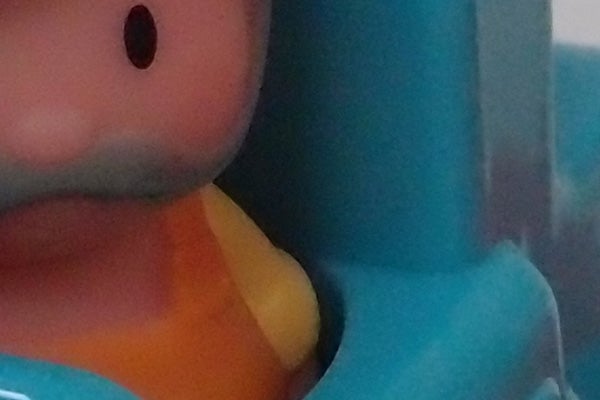
ISO800 and again as expected there’s noise and incremental softening of detail, but not to an extent that we wouldn’t happily live with.
—-

A more noticeably sandy look across the entire image at ISO1600, upon close inspection of a cropped section, but less abrasively intrusive when viewing the frame as a whole. Again, we’d be happy to shoot at this setting.
—-

Even without zooming in, our test shot subjects are taking on a felt-like consistency as detail softens further at ISO3200. You might get away with it if converting the shot to black and white, but this is a setting we’d rather avoid if we have the option.
—-

A rather more gritty appearance at ISO6400 and overall softness to the image that just makes it look blurred, so this is one to definitely avoid.
—-
”’A more general selection of test shots are revealed on this page and next to act as an evaluation of the XZ-1 in a variety of shooting conditions. Unless otherwise stated we were using the camera’s ‘Natural’ colour setting, and auto white balance.”’
—

This wide angle shot at f/4.5 and ISO100 reveals little in the way of leaning verticals or barrel distortion, and moreover a sharp level of detail with rich yet natural colours straight out of the camera. The detail of the brickwork has been commendably preserved, there is some pixel fringing on the upper tree branches but only on close inspection, and the image is evenly exposed. A good showing from the Olympus that’s a cut above your average point and shot camera certainly.
—
By contrast a handheld close up interior image, at f/2.8 and again ISO100. OK, the natural lighting here was ideal, but the Olympus has nevertheless excelled, again delivering bags of detail, lovely natural colours and another even exposure.
—

And an exterior close up at f/2.5. Again, a perfect result straight from the camera that we have not adjusted in any way. The level of detail is such that we can pick out flaking paint work and small rust spots on a structure that at first glance appears stately and magnificent. OK, so more pixels may just deliver more detail – but we’re more than happy with what’s been produced with 10 megapixels here.
—
Here are some general test shots taken with the XZ-1 as stated to give an idea of performance ability when it comes to image quality, colour rendition and the kind of results achievable with Olympus’ much trumpeted built-in Art Filter effects, when used in moderation. We’ve focused on this feature because it provides a notable point of difference over the camera’s immediate rivals.
—-

As we’ve noted in the main body of our review, the XZ-1 shoehorns in a range of digital effects under the umbrella of Art Filters. This is an example of what’s achievable with Dramatic Tone selected. Pick the right subject and this particular filter is very effective indeed, results somewhat akin to a high dynamic range shot with detail maintained in both sky and foreground lending it a distinctly otherworldly feel.
—-

And here’s an image that has been taken with the Diorama mode selected instead, which narrows the area of the image in focus to a central band and blurs the rest. The idea is that full-size subjects are rendered as if in miniature. We found results a bit hit and miss – occasionally it can just resemble a lens fault – with the example here being one of our better attempts at using it to its full potential.
—-

Three side by side shots to show how deploying select Art Filters on the same subject can produce results that we’d argue work equally well, just in a different fashion. From the top we have the most natural, true to the scene image taken in regular Program mode, the middle image with the enhanced contrast and colours is recognisably the Dramatic Tone filter, whilst the third (bottom) example is with Pop Art deployed. Again, notable for its boosted colours somewhat reminiscent of the results achievable with a set of poster paints on canvas.

—-
Trusted Score
Score in detail
-
Value 8
-
Image Quality 9
Features
| Camera type | Digital SLR |
| Megapixels (Megapixel) | Megapixel |
| Optical Zoom (Times) | 12 Xx |
| Image Stabilisation | Optical |
| LCD Monitor | 3 in |
| Flash modes | Auto Flash, Flash OFF, Flash ON, Red-eye Reduction |
| Video (max res/format) | 640 x 480 |

